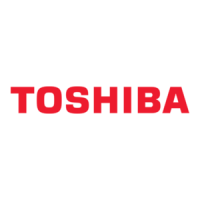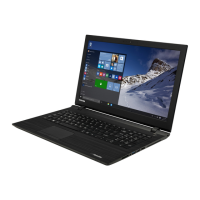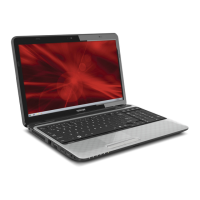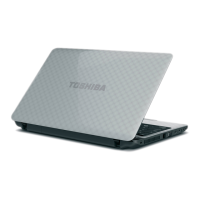
Do you have a question about the Toshiba L70-B and is the answer not in the manual?
| Storage | 1TB HDD |
|---|---|
| Operating System | Windows 8.1 |
| RAM | 8GB DDR3 |
| Display | 17.3-inch HD+ (1600x900) |
| Weight | 2.7 kg |
Copyright, disclaimer, and trademark information for the manual and computer.
Details FCC compliance, declarations, and notices for digital devices.
States compliance with EU directives, CE-Marking, and RoHS Directive.
Specifies approved and unapproved working environments for the product to ensure safety.
Details compliance with Canadian Department of Communications regulations.
Instructions for proper disposal of products and batteries according to EU guidelines.
Guidance on the separate collection and disposal of batteries and accumulators.
Statement on compliance with EU's REACH chemical regulation requirements.
Disposal instructions specific to Turkey and India.
Information regarding licensing for personal and non-commercial use of video standards.
Details ENERGY STAR compliance, energy efficiency guidelines, and power saving features.
Guidance on discarding the computer and its rechargeable batteries according to laws.
Precautions for safe use of the optical disc drive, including laser system warnings.
Shows label location and provides cautions for laser product operation.
Lists the hardware and documentation included with the computer for setup.
Explains formats used in the manual for terms and operating procedures.
Provides basic information and guidance for initial computer setup and operation.
Instructions on how to connect the AC adaptor for power and battery charging.
Instructions on how to open the display panel and adjust its angle for optimal viewing.
Steps to power on the computer and initial operating system setup.
Overview of Windows features like Start Screen, Taskbar, Charms, and Tiles.
Procedure for turning off the computer completely, saving data before shutdown.
Methods for restarting the computer, including using the power icon or keyboard shortcuts.
How to put the computer into Sleep Mode to pause operations without exiting software.
How Hibernation Mode saves memory contents to disk for later restoration.
Illustrates the front of the computer with the display panel in the closed position.
Details ports and slots on the left side of the computer, including USB and optical drive.
Details ports on the right side, including headphone, microphone, USB 3.0, HDMI, and LAN.
Identifies components on the back and underside of the computer, including battery pack.
Shows and describes components visible when the computer display is open.
Details the built-in microphone and web camera, including usage and care instructions.
Describes the display screen specifications and keyboard features.
Explains the function and operation of the Touch Pad for controlling the on-screen pointer.
Details CPU, Hard Disk Drive/SSD, and their performance factors.
Describes power states and the meaning of the DC IN/Battery indicator lights.
Explains various touch gestures for operating the Touch Pad, such as tap, scroll, and swipe.
Details the keyboard layout, keys, and indicator lights like CAPS LOCK and NUM LOCK.
Explains the functionality of standard and special function keys (F1-F12).
Describes Windows keys and how to generate ASCII characters using codes.
Information on DVD Super Multi and Blu-ray Writer drives and supported formats.
Instructions on loading and removing discs from the optical drive.
Guidelines and precautions for writing data to CDs, DVDs, and Blu-ray discs.
Notes on using CyberLink PowerDVD, including limitations and system requirements.
Notes on using the Blu-ray Disc Player, including limitations and playback requirements.
Details requirements for 3D playback on external devices via HDMI, including resolutions.
Safety warnings regarding potential health effects and proper use of 3D viewing.
Notes on 3D playback features, conversion, and copyright considerations.
Information about the battery pack and the Real-Time Clock function.
Important safety precautions for handling, installing, and removing the battery pack.
Procedures and table for charging the battery pack, including charging times.
Methods for monitoring battery power and tips to extend operating time.
Approximate battery duration and monthly procedure to maximize battery lifespan.
Instructions for removing and installing the computer's battery pack.
Details LAN cable types and steps for connecting to a LAN network.
Information about memory media slots, compatible cards, and care instructions.
Explains memory media formatting, care precautions, and write-protect features.
Instructions for inserting memory media into the computer's slot.
Instructions for safely removing memory media from the computer.
Information on enhancing computer video capabilities with additional displays.
Steps for connecting external displays via available ports like RGB and HDMI.
Details on connecting devices via the HDMI port for video and audio transfer.
Configuring HDMI video and using wireless display technology.
Managing display settings and using the security lock slot for theft prevention.
Lists available optional accessories like AC adaptors and battery packs.
Utility for controlling audio volume for playback devices and applications.
Adjusting microphone levels and applying sound effects for speakers.
Details DTS Sound features for immersive surround sound and dialog enhancement.
Describes pre-installed utilities like Display Utility and Password Utility.
Customizes hardware settings and peripherals for work and usage preferences.
Software for playback of DVD Video and Blu-ray Discs, with usage details.
BIOS setup utility for viewing and changing BIOS settings via a menu interface.
Manages power consumption, offers eco modes, and peak shift function for energy savings.
Helps manage and share multimedia content, organizing photos and videos by event and date.
Utilities for function keys and searching for TOSHIBA software updates.
Monitors system functions like power, battery, and cooling, informing about significant conditions.
Plug-in for upconverting WMV and MP4 videos in Windows Media Player.
Details features like automatic power off, sleep/hibernation, and intelligent power supply.
Explains Sleep Mode for pausing operations and Hibernation Mode for saving system state.
Functionality for waking computer via USB and managing processor temperature for heat dispersal.
Instructions for setting, deleting, and changing user passwords using the utility.
Setting Supervisor passwords and procedures for starting the computer with a password.
Overview of System Settings tabs for BIOS, Sleep/Charge, Display, Boot Options, etc.
Explains USB Bus power supply to USB ports, including Sleep and Charge functionality.
Details USB charging modes and function behavior under battery power.
Enables/disables CDP for rapid USB charging when the computer is powered on.
Monitors system functions, collects data for diagnostics and quality assurance.
Details system recovery options, creating recovery media, and restoring the system.
Instructions for restoring the computer using created recovery media, including BIOS settings.
Procedure for restoring the system using the recovery partition on the Hard Disk Drive.
Guidelines for diagnosing problems and basic checks for peripherals and configuration.
Questions to consider for identifying the root cause of computer malfunctions.
Troubleshooting issues related to software loading, errors, or media corruption.
Checking hardware setup and configuration when software issues are not found.
Procedures for unresponsive keyboard, frozen programs, and startup failures.
Procedure to load advanced startup options like BIOS or Recovery when desired.
Lists common problem areas including Power, Keyboard, Display, Drives, and Connectivity.
Addresses computer shutdowns due to overheating and AC adaptor power problems.
Troubleshoots battery charging issues and short battery power duration.
Troubleshooting RTC, keyboard input, and internal display panel problems.
Troubleshooting HDD boot failures, slow performance, and optical drive access issues.
Troubleshoots memory card errors and Touch Pad functionality problems.
Troubleshooting issues with USB mouse operation, including pointer response and double-tapping.
Troubleshooting when USB devices do not work, ensuring proper driver installation.
Troubleshooting problems with the Sleep and Charge function, including battery depletion and device compatibility.
Troubleshooting no sound or annoying sounds, checking volume settings and connections.
Troubleshooting issues with external monitors not turning on, no display, or display errors.
Troubleshooting issues with accessing the LAN, ensuring firm cable connection.
Troubleshooting Wireless LAN and Bluetooth connection issues.
Steps to take before contacting TOSHIBA support, like reviewing documentation and troubleshooting.
Information on contacting TOSHIBA technical support for hardware-related issues.
Summarizes technical specifications including physical dimensions and environmental requirements.
Details power requirements and pin assignment for the external RGB monitor port.
Specifications for AC power cords, connectors, and certification agencies.
Details on wireless technology interoperability, Bluetooth, and Wireless LAN standards.
Information on electromagnetic energy emitted by wireless products and their safe use.
Details Wireless LAN technology, compatibility, and recommendations for securing connections.
Information on radio frequencies, interference, and Bluetooth technology features.
Restrictions for use of 2400-2483.5MHz and 5150-5350MHz frequencies in Europe.
Restrictions for use of 5470-5725MHz frequencies in Europe.
Details compliance with Industry Canada and FCC regulations for digital devices.
Regulatory information for using the equipment in Taiwan and Japan.
Shows and explains indications related to Wireless LAN and Bluetooth equipment.
Lists radio equipment certifications and country approvals for wireless devices.
Explains non-applicable icons and factors affecting CPU performance.
Notes on memory usage, battery life factors, and 64-bit computing compatibility.
Details HDD capacity, LCD, GPU performance, and Wireless LAN specifications.
Information on copy protection and VCCI Class B compliance for Japan.
Details the dual license terms for the OpenSSL toolkit and contact information for license issues.
Details the FreeType Project license, terms of use, and distribution conditions.











